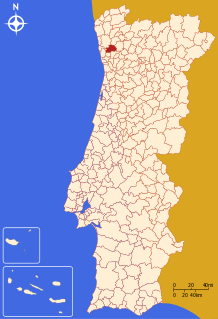

|
Add links
|
|||
| Line 78: | Line 78: | ||
{{See also|List of twin towns and sister cities in Portugal}} |
{{See also|List of twin towns and sister cities in Portugal}} |
||
*{{Flagicon|France}} [[Saint-Fargeau-Ponthierry]], |
*{{Flagicon|France}} [[Saint-Fargeau-Ponthierry]], [[France]], since 1989 |
||
*{{Flagicon|France}} [[Givors]], [[France]] |
*{{Flagicon|France}} [[Givors]], [[France]], since 1992 |
||
*{{Flagicon|Brazil}} [[Caruaru]], |
*{{Flagicon|Brazil}} [[Caruaru]], [[Brazil]], since 1999 |
||
*{{Flagicon|Cape Verde}} [[São Vicente, Cape Verde|São Vicente]], [[Cape Verde]] |
*{{Flagicon|Cape Verde}} [[São Vicente, Cape Verde|São Vicente]], [[Cape Verde]], since 2000 |
||
*{{flagicon|Sao Tome and Principe}} [[Lobata District]], [[São Tomé and Príncipe]] |
*{{flagicon|Sao Tome and Principe}} [[Lobata District]], [[São Tomé and Príncipe]], since 2013 |
||
*{{Flagicon|Mozambique}} [[Mocuba]] |
*{{Flagicon|Mozambique}} [[Mocuba]], [[Mozambique]], since 2012 |
||
*{{Flagicon|Spain}} [[Arteixo]], |
*{{Flagicon|Spain}} [[Arteixo]], [[Spain]], since 2016 |
||
==Notable people== |
==Notable people== |
||
Vila Nova de Famalicão
| |
|---|---|
 | |
| Coordinates: 41°24′N 8°31′W / 41.400°N 8.517°W / 41.400; -8.517 | |
| Country | |
| Region | Norte |
| Intermunic. comm. | Ave |
| District | Braga |
| Parishes | 34 |
| Government | |
| • President | Paulo Cunha (PSD-CDS) |
| Area | |
| • Total | 201.59 km2 (77.83 sq mi) |
| Population
(2011)
| |
| • Total | 133,832 |
| • Density | 660/km2 (1,700/sq mi) |
| Time zone | UTC±00:00 (WET) |
| • Summer (DST) | UTC+01:00 (WEST) |
| Website | http://www.vilanovadefamalicao.org |
Vila Nova de Famalicão(Portuguese pronunciation: [ˈvilɐ ˈnɔvɐ ðɨ fɐmɐliˈkɐ̃w] ⓘ) is a Portuguese town with a population of approximately 140,000 inhabitants (133,048 inhabitants – 2011,[1]) in an area of 201,59 Km2, subdivided into 49 parishes (Administrative Division of 11 Unions of Parishes and 23 Parish Councils,[2]). Inserted in the Braga District, in the North Region of Portugal and in the Sub-Region of Vale do Ave, global positioned at 41⁰24’36” N | 8⁰31’13.53” W. The population of Vila Nova was created in 1205 with the charter given by the King Sancho I. The municipality was created in 1835 as a detachment from Barcelos and was elevated to the category of “Vila” with the charter given by the Queen D. Maria II. In 1985, approved by National Assembly, Vila Nova de Famalicão was elevated to the category of City. The inhabitants of Famalicão are called Famalicenses.
Frequently known simply as Famalicão, the city is the south entrance of the Minho province and the last reference of the Minho province for whoever comes from the North of Portugal and the Spanish region of Galicia. Since ancestral times, its privileged location has been a motivation for the passage and fixation of other people who left marks of their ways and culture in the territory, still easily found nowadays. The municipality is bordered by Braga to the north, by Guimarães to the east, by Santo Tirso and Trofa to the south, by Vila do Conde and Póvoa de Varzim to the west and by Barcelos to the northwest. Due to its privileged location, Famalicão is currently served by a network of modern roads, with one of the most important motorway junctions of the country – A3 (Porto – Vigo) and A7 (Guimarães – Póvoa de Varzim), as well as a train service with direct connections to Braga, Guimarães, Porto, Vigo, Coimbra, Lisbon and Algarve.
Because of this strategic positioning, Famalicão is today mentioned as one of the main cultural, commercial and industrial centres of the country. The strength of its diverse industry and socio-economic dynamics are prominent features at national and international level. Vila Nova de Famalicão hosts the headquarters of some of the largest and best companies in the country in various industry sectors, with its maximum strength in the Textile and Clothing, Automotive, Agrofood and Metal-Mechanics sectors, giving it the 3rd place in the most exporting municipalities of the country and one of the major industrial economies in the North.
Land of the writer Camilo Castelo Branco, whose house-museum is part of a network of 13 museums, which also includes the Portuguese Centre of Surrealism, the National Railway Museum – Lousado Museum Centre, and the Textile Industry Museum – Ave Basin, among others.
Vila Nova de Famalicão is a city to visit, for the dynamics of its sports associations, for its diverse cultural offer – which has its greatest exponent in Casa das Artes -, for its rural, religious and industrial tourism, for its festivities and celebrations, for its rich gastronomy and its cultural and industrial heritage.
Administratively, the municipality is divided into 34 civil parishes (freguesias):[3]
The economy of the municipality is mainly based on textile and food industries.
This Braga District location article is a stub. You can help Wikipedia by expanding it. |